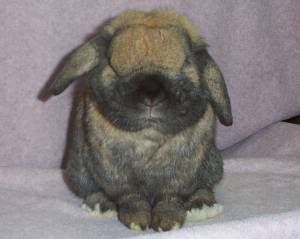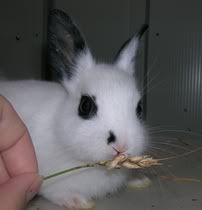by Laurie Stroupe

I’m in the process of researching a new feed for my barn. I just don’t feel that I have the condition that I once did – on these same rabbits.
To say that feed issues are mind-boggling is an understatement. And forget about asking people about how they like their feed. You will find people who LOVE and HATE each brand of feed with a passion. The one exception is that if you find a feed everyone loves, it won’t be available in your area!
The horror stories are so vivid that it makes one afraid to feed anything, but, of course, not feeding is not an option. And if you read the advertisements for feed, they all sound so wonderful.
So, I have to go back to my own philosophy on feed (or develop a philosophy if I don’t have one). Then I’ll have to try it, evaluate the outcome, and make up my own mind.
My feed philosophy includes a stand on freshness. I’m not interested in the acceptable shelf life of a feed. I’m interested in whether I will be able to get a consistent supply of very fresh feed. Up to two months is ideal to me; up to three months is acceptable. After that, I’m not interested.
I’ve fed an extruded feed for the last couple of years. I had heard glowing reports (from the manufacturer, of course) of the studies on extruded feed. The rabbits were able to use the nutrients more effectively, I’m told. But more recently, it was brought to my attention that rabbits should eat a raw diet (makes sense) and extruded feed is cooked and then refortified. I’m unsure of the facts now, but I have to say that I’m leaning toward the raw diet (pellet) idea more.
So I want fresh feed and I want it in pellets – small ones. But what about the ingredients. Sure, I recognize some of the ingredients. But what the heck is the rest of that stuff? And how do I feel about it?
(Remember, I’m not a rabbit nutritionist, just giving my opinion as a breeder.)
Common Ingredients found in Rabbit Feed and Their Purposes
Here are some common ingredients, my understanding of what they are, and my philosophy on each:
1. Alfalfa/Alfalfa Meal – either alfalfa or Timothy hay should be the first ingredient – meets the high fiber/low carbohydrate needs of rabbits – great ingredient
2. Oats/Pulverized Oats – oats are a low-glycemic source of carbohydrates – remember that if you add oats to a pellet already high in oats, you may push your rabbits over their carb limit – good ingredient
3. Wheat Germ/Wheat Germ Meal – Another source of fiber and carbohydrates in a low-glycemic form, also a source of fat – great ingredient
4. Ground Barley – similar to oats

5. Wheat Midlings – Another name for wheat midlings is farina or midds. According to Dr. Getty, horse nutritionist, wheat midlings are considered low starch. One article I read called wheat midlings “what was left over once you took out everything nutritious” and “floor sweepings.” Wheat midlings are palatable and contain 16.5% protein. Wheat midlings serve a role in keeping the pellet together – unsure about this one – if it’s in there, I don’t want it too high on the ingredient list.
6. Soybean Meal – a source of protein and fat – good ingredient
7. Hydrolyzed Milo – milo is a grain resembling millet – still trying to figure out why it is hydrolyzed – to make it more digestible maybe? undecided.
8. Distillers Dried Grains and Soluables – the Distillers Grain Council lists these advantages for distillers grains: Starch Removed , Fermentation Process, High Fiber, Dried Yeast Cell Content, All Natural Process, FDA Food Grade, Highly Digestible Protein (85%), Concentrated Grain Nutrients, Bypass Protein, Essential Minerals – sounds good to me.
9. Linseed Meal – linseed meal is what is left once the linseed oil is extracted – it is a source of protein – also adds to the palatability (makes it taste good) – excellent ingredient
10. Sodium Chloride – salt – excellent ingredient in the right proportion, should be listed down with the small stuff like vitamins
11. Dried Streptococcus Faecium Fermentation Product – this sounds awful and dangerous – who wants strep? well, apparently, we do. This ingredient is often found in rehydration, electrolyte, and probiotic preparations, including Benebac Gel. Excellent ingredient
12. Lactobacillus Acidophilus Fermentation Product – supports gut function – excellent ingredient
13. Yeast culture (Saccharomyces cerevisiae) – stimulates beneficials in the hindgut, improves phosphorus digestibility – excellent ingredient
14. Dried Aspergillus Oryzae Fermentation Extract/Dried Aspergillus Niger Fermentation Extract – both of these provide GI tract support – excellent ingredients
15. Artificial flavors – I’m dubious about anything “artificial” – this better be the last ingredient if it’s there at all (I’m okay with natural flavors)
16. Yucca Schidigera Extract – reduces ammonia production – extra great ingredient
17. Animal Fat – rabbits are vegetarians, folks – this one makes no sense to me
18. Corn Syrup Solids – I shun this ingredient in my own food – I personally think it is a too high glycemic for Hollands, don’t know about other breeds, though – poor ingredient
19. Papaya Fruit Powder – I think I’d be okay with this one, but I’d have to be convinced that the enzymes were still active after the powdering process – undecided
20. Casein – milk protein (curds) – I’m of the opinion that most adult animals do not tolerate milk products very well – I’d wonder about allergic reactions – undecided
21. Dried whey – you’ve seen whey – the watery stuff in your cottage cheese – again, I wonder about milk allergies – whey is a source of protein, containing about 1/3 more than corn – whey also retains most of the milk sugar – undecided, but leaning against since I don’t want much simple carbohydrate in my rabbits’ diet
22. Protease – digestive enzyme needed to digest protein – sounds fine
23. Cellulase – an enzyme that breaks down cellulose (plant cell walls) into glucose – supports GI activity – sounds good to me
24. Betaglucanase – a blend of three enzymes that work to break down plant fibers – a digestive enzyme – again, it sounds like a good thing
25. Lactase – helps the digestion of milk – sounds like something that would be useful for young rabbits still nursing
26. Ethylenediamine Dihydriodide – source of iodine – okay
27. Cane Molasses/Molasses Products – 50% sugar content, adds to the palatability of the feed, adds minerals – aids in keeping the pellets together which I suppose may reduce fines – I do not like molasses in my feed – must be one of the smaller ingredients, not in the top 5, but I’d prefer none – questionable ingredient
28. Sunflower Seeds – source of oil – aids in conditioning – good ingredient
29. Corn – high glycemic grain – I think corn stresses a rabbit’s system and can lead to obesity – poor ingredient
30. vegetable oil – check the percentage of fat to make sure that it’s in line with your feeding philosophy, if so, then this ingredient is okay
31. Dl-methionine – an essential amino acid – precursor to SAMe – isn’t that a mood elevator? Maybe some of those high strung rabbits aren’t getting enough of this – undecided
32. Oat hulls, rice hulls – these are added to add fiber only and not nutrition per se – just check the fiber range of the feed to make sure it is in line with your feeding philosophy – okay
I didn’t list the multitude of vitamin supplements, but I would like to note that if you are giving a supplement on top of a supplemented feed, you are doubling your rabbits’ vitamins already, so be aware of what’s in which product.
Well, I hope you learned at least one thing from this list. I know I learned a lot more than one thing by making it. Next time I read an ingredient list on a bag of feeds, I think I’ll be able to read it with more understanding.
![]()
Next Article: Help for when your rabbit won’t eat
